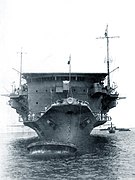Ryūjō (1933)
The Ryūjō or Ryūjyō (龍驤 rampant dragon ?) was a light aircraft carrier of the Imperial Japanese Navy. She was built at the Mitsubishi shipyard in Yokohama in 1929, launched in 1931 and commissioned in 1933.
Its very characteristic design of only 8,000 tons quickly earned a poor seafaring reputation as it proved almost inoperable as an aerial platform and as an offshore vessel under rough sea conditions due to its strong instability.
In the same decade of the 30's, in the years 1934 to 1936 it was profoundly modified to make it more seaworthy, its beam was widened to lower the center of gravity and its forecastle deck was raised to make it less "humid", since seawater used to easily beat it with the original design. After improvements, it was used in the Second Sino-Japanese War.
The Ryūjō had a continuous deck that was shorter than the length up to the command bridge area located in the front. It had its armament on platforms very protruding from the structure, its funnels were on the starboard side and angled downwards towards the rear, it had particularly low gunwales. The aft elevator shaft turned out to be small for the new generations of embarked aircraft, but Despite everything, the Ryūjō had active participation in the Second Sino-Japanese War where sea conditions were more favorable to it. Furthermore, its armor was very poor, not exceeding 20 mm thick horizontally and 25 mm vertically.
During World War II it was commanded by Captain Tadao Kato, and became the flagship of the 4th Aircraft Carrier Division. After participating in the Japanese invasion of the Philippines, she was assigned to secondary operations compared to those carried out by the large aircraft carriers then active. This situation changed after the loss of four large aircraft carriers in the Battle of Midway, during which she participated in the attack on the Aleutian Islands alongside the aircraft carrier Junyō. After Midway she was again assigned to the front line.
She was used as a decoy during the Battle of the Eastern Solomons and sunk on August 24, 1942, north of Guadalcanal by an air attack by the aircraft of the USS Saratoga (CV-3), after being hit by several bombs (their number differs depending on versions) and a torpedo. 120 members of her crew went down with the ship.
Ryūjō Image Gallery
Ryūjō's stern view.
Ryūjō bow view.
The Ryūjō as a decoy during the battle of Eastern Solomons (24 August 1942).
Contenido relacionado
520
484
Nobel Prize in Chemistry


